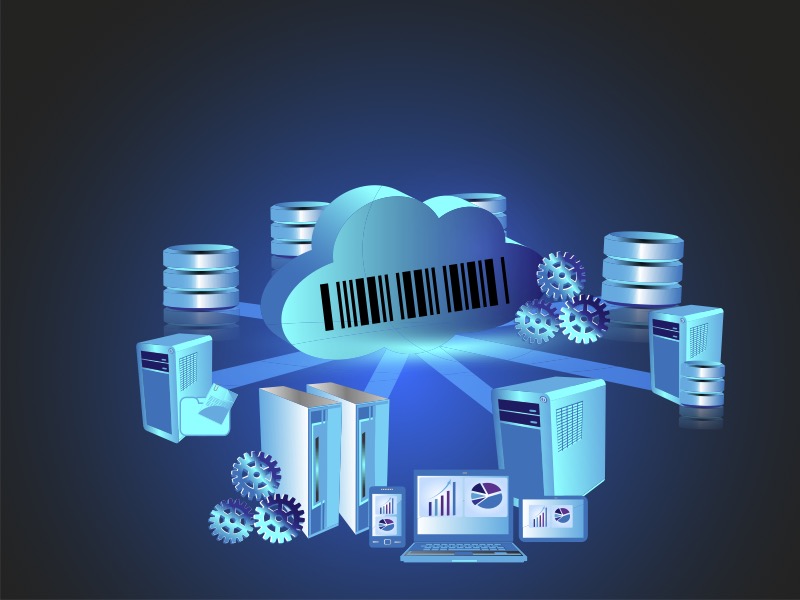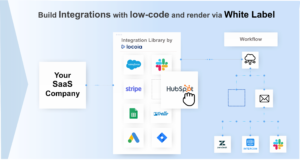Embedded Integrations – Everything you Need to Know

Embedded white label integrations, which are basically API integrations, have become an indispensable part of today’s corporate technology infrastructure, as most customers require them.
With an average of over 100 SaaS applications alone that usually are not connected to each other, it is very easy to lose track. In case of a business not being able to offer the appropriate integrations, they may even lose new prospects and customers.
But how can companies offer integrations for their customers without getting into huge development costs and risks? This is where independent software providers come in. In the following article we explain how embedded white label integrations work and how companies can use them.
Content
1. What are embedded white label integrations?
Embedded White Label Integration, are basically API integrations that companies can obtain from an external software provider via a licensing agreement. With these embedded iPaaS solutions companies can offer integrations within their own corporate identity.
Thus the quick and easy white label integration will subsequently result in an increase of customer satisfaction. And at the same time attract more new customers.
“”(…) procurement leaders rank lack of integrations as the third biggest barrier to effective technology adoption.” Deloitte
In order to offer integrations, companies have the option to build them themselves with their in-house development team. However, this is a very lengthy and costly process. Alternatively, they can use an independent software vendor that immediately offers a white-label integration platform for a monthly or annual license fee.
These embedded integration platforms, allow companies to offer integrations under their own name and label. Companies should make sure that the platform provider includes the following points:
- Visual user interface/ clear dashboard
- Drag and drop function as part of a low-code approach
- Fast implementation
- Data security
- in Germany: data protection according to DSGVO
The integration platform can be used internally as customized integrations for customers or as an extension of the company software. In the latter case customers can set up their own integrations themselves with the help of a configuration wizard.

Difference iPaaS and embedded white label iPaaS:
Classic iPaaS (integration Platform as a Service) is intended for businesses as end users to use as a solution for their own operations.
Embedded iPaaS is intended for companies that want to make integrations available to their customers in their own system or app with their own branding.
Perhaps interesting: iPaaS: Definition, advantages and the most important functions
2. Who are embedded white label solutions for?
Embedded white label solutions are the ideal solution for SaaS companies that want to be able to offer integrations quickly and easily to their customers.
Often, SaaS startups and companies do not have the capacity to build additional integration options for their customers themselves. To meet the high demand, they can use an embedded white label platform. The company’s IT teams can thus concentrate on product development and improvement. The customer experience remains the same as the integration software will be white labeled.
Embedded white label solutions are particularly interesting for the following two departments:
Product management: as it is responsible for managing technical resources.
IT department: as it can fully focus its time and resources on product improvements.
Tailor-built integrations for SaaS companies
Fulfill your customers’ integration requirements with no effort and increase their stickiness
3. Integration challenges for SaaS companies
Software and service companies, especially SaaS companies, need to be able to offer integrations to their customers. Customers want their data to flow easily between applications in order to avoid data silos. Above all, they do not want any additional manual or even personnel effort through the use of external third-party systems. As long as their own product cannot be easily integrated with the customer’s, the customer will most likely look for another company that can do just that.
Companies that want to provide integrations themselves are confronted with the following challenges:
3.1 Cost and time
As mentioned, creating integrations in-house is a very time-consuming and costly process. The IT department must carefully allocate resources between the development of the integration and product development. Usually, companies also need more staff, because not only the creation, but also the maintenance and updates require a lot of time and resources. When outsourcing to a third party provider, the time saved can be used for the development of their own product.
3.2 Complex administration and creation of connectors
As a rule of thumb, the more customers a company has, the more different connectors or APIs are needed. Creating and maintaining each of these means a considerable amount of extra work. On the part of the customer, this often means a considerable delay in the project. An external platform usually offers more than 500 connectors.
3.3 Lengthy customer onboarding process
If companies cannot directly provide their customers with the appropriate integration, this can lead to a lengthy onboarding process. It might result in frustration on the part of the customer and, in the worst case, to termination.
4. How do white label integrations work?
This is how embedded white label solutions from an external software provider work:
- Instead of programming the integration themselves, a professional integration platform is used to capture the integrations requested by the customer.
- Using a drag and drop function, data can be formatted, moved and forwarded between different apps without any programming knowledge. Good software vendors usually provide the drag and drop function as part of their low-code approach.
- Once configured, different workflows can be set up to automate and also synchronize the relevant processes.
- Through the white label function, the customer will stay within the company’s app, so the customer experience is not disrupted by external providers.
- Configuration wizards guide the customer through the integration process.
So basically, an embedded white label solution allows a company to provide its customers with an iPaaS solution to link its own software products with those of its customers.
User-friendly low-code UI
Make your team independent of developers. Build custom integration flows via drag and drop – as business users
5. All advantages at a glance
5.1 Time advantages
As already mentioned, a low-code white label platform relieves the IT department immensely.
Not only is the time for building integrations saved, but also the time-consuming search for developers, who are already very difficult to find. The existing team, both in IT and in HR, has more time and resources to focus on the core business.
5.2 Customer satisfaction
If integrations run smoothly, not only your company benefits, but also that of your customers. Because nothing is more frustrating than not functioning integrations. As a result, customers’ projects may also be delayed, which can lead to immense customer dissatisfaction and even loss of customers.
By deploying a third-party provider, companies can offer more connectors to their customers. In addition, these can be handled much more error-free and, above all, faster. The result: customer satisfaction increases and the integrations provided bind customers to the company, as the own product is integrated into the customer’s IT infrastructure.
5.3 Higher ROI
By offering customers considerable added value, the sales price can be increased accordingly. In addition, the more integrations the customer deploys, the closer the customer’s loyalty will be. And the likelihood that the customer will stay within the long term increases immensely.
Also the saved costs need to be considered: a software license by subscription can save up to 90% of the costs in individual cases. These saved costs can flow directly into the profit, which in total leads to a higher return on investment.
6 Conclusion and summary
These relatively new embedded integration solutions will become a decisive success factor for SaaS companies in the highly competitive market. Due to the massive increase in the number of programmes used, fast integration solutions will be a key decision-making feature for many customers.
